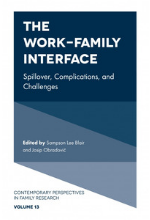Finding Ways to Help Mothers Balance Work and Family Life


James M. Loy, Miami University
Many people feel the struggle of balancing work and family life, and some, working mothers especially, often feel it more than most.
In recent decades, employees have faced a rising tide of demands. From longer hours and erratic schedules to new technologies that blur the lines between the professional and the personal. Both men and women have been forced to adapt to increasingly dynamic workplaces.
But the division of labor is still fraught with disparity, because many working women are often burdened with additional expectations, cultural biases, and systemic inequalities that can increase the conflicts and disrupt the balance between their work lives and their family lives.
“For working women, it is becoming a serious problem,” says Hassan Raza, Miami University visiting assistant professor of family science and social work. “Because compared to the past, more women are working. Almost 50% of the workplace is made of women. So they are experiencing challenges in the workplace based on the intersection of race, class, and gender. At the same time, they are also doing most of the work in the household.”
When compared to men, women still spend almost twice as much time on household chores and over twice as much time caring for children and family members. Plus, women also generally report being more dissatisfied with their work-life balance overall.
So Raza is concerned with helping working women, mothers in particular, successfully navigate within and between these spaces.
By combining advanced data analysis and complex statistical modeling with bioecological theory, he studies how reciprocal interactions between working mothers and their partner in the family and supervisors/coworkers in the workplace change over time and either increase or decrease the work-related conflicts and imbalances they face.
Bringing bioecology to family science
In two recent longitudinal studies, Raza and his colleagues examined both work-family conflict and work-family balance among working U.S. mothers.
 In the first study, published as a book chapter in Work-Family Interface: Spillover, Complications, and Challenges, conflict was defined as times when women felt the demands of work interfered with their family life and vice versa. After accounting for age and marital status, the primary findings showed that working a nonstandard schedule greatly increased work-to-family conflict, while relationship quality significantly decreased family-to-work conflict.
In the first study, published as a book chapter in Work-Family Interface: Spillover, Complications, and Challenges, conflict was defined as times when women felt the demands of work interfered with their family life and vice versa. After accounting for age and marital status, the primary findings showed that working a nonstandard schedule greatly increased work-to-family conflict, while relationship quality significantly decreased family-to-work conflict.
Raza also found that women’s work-family conflict experiences change over time and these experiences differ among women.
“Those women who work a nonstandard work schedule, they are more underprivileged,” Raza says. “They have less education. They are single mothers. They are non-white. They are more vulnerable. [And] if we can't bring them from the nonstandard to the standard work schedule, at least we can understand their individual needs. We can make the reciprocal interactions and the context supportive of them. That can help them reduce their work-to-family conflicts.”
In a follow-up study, Raza and his colleagues also looked at work-family balance, and again, the research highlighted the importance of relationship quality, as well as a clear socioeconomic divide.
The researchers found that the presence of positive relationships at home was more likely to “spillover” into their experiences at work and increase their sense of work-family balance. This was found to be particularly true for white mothers who worked for employers that had family-friendly policies in place.
“So those mothers who are already privileged,” Raza says “who are highly educated. Who are white. They are more likely to work in those workplaces where they have more family-friendly policies available. If they have family-friendly policies available, it magnifies the effect of relationship quality on work-family balance by creating positive family-to-work spillover.”
Advice for employers
For Raza, both studies suggest clear ways employers can help more working mothers thrive.
First, he says, employers should understand and acknowledge the wide range of diversity among working mothers.
“I found that each mother is different. So it is extremely important for employers to understand their individual contexts, their individual needs. This is one thing they can do to help these working mothers maintain a healthy work-family balance, and to reduce work-family conflict.”
Whenever possible, he says employers should provide working mothers with more flexibility over their work schedule, offering more family-friendly policies such as child care, elder care, and insurance coverage can also help.
Finally, both studies clearly highlight the importance of strong relationships at home. However, Raza also stresses the importance of positive reciprocal interactions within the workplace as well, particularly with supervisors and coworkers.
Raza further emphasized that these positive reciprocal interactions should continue on a regular bases and for extended periods of time and should be progressively more complex, such that supervisors should provide opportunities to working mothers to learn new skills instead of doing the same work all the time and throughout their career.
“Employers really want to make sure that people, supervisors especially, provide instructional and emotional support,” he says. “If employers can create an environment that fosters collaboration, and that emphasizes strong relationships between co-workers, working mothers are more likely to experience a healthy work-family balance, and it will also help them reduce their work-to-family and family-to-work conflict.”

